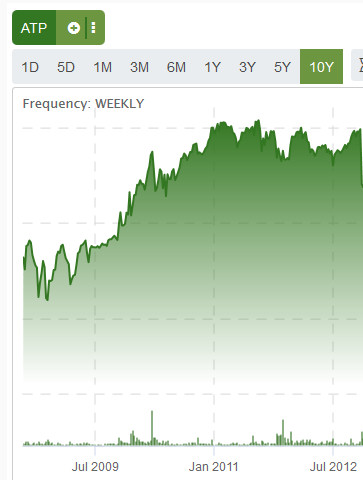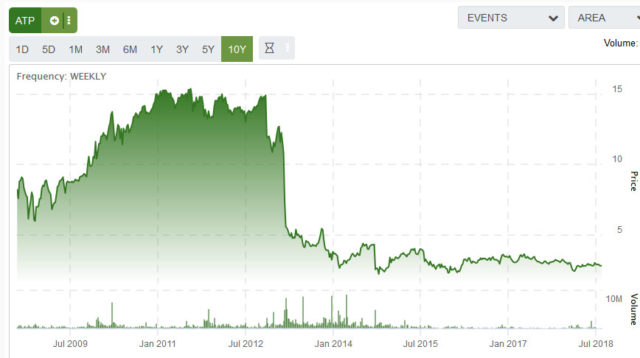I remember over five years ago everybody was talking about how Atlantic Power (TSX: ATP, NYSE: AT) was this great income stock – looking at their 2012 year-end financials, they ramped up from nearly nothing to $440 million in revenues, and produced $167 million in cash flows through operating activities and was building more capacity. They were paying out more than a dollar a share in dividends, and look at the stock price! They got up to CAD$15 in 2011 when times were great.
The mantra at the time: They paid huge dividends! And in a stable utility business, power generation! The good times will last forever! What can be greater than that?
Of course, I didn’t buy any of it – the business was not a utility, it was in the independent power generation industry, which relies upon power purchase agreements to sell power to either industrial or regulated utilities. Back in 2010, there were capacity issues in the industry which lead to very good pricing conditions and this created a huge capital influx on these sorts of assets.
Once these power agreements started to abate, the results for investors was catastrophic (rest of the chart attached):
You can see the archive of entrails of mis-applied value analysis at Seeking Alpha, where notably some “Editor’s Picks” in 2013 affirmed that Atlantic Power was the best thing since sliced bread. Sadly they’re behind a paywall but the headlines should provide some historical amusement.
In March of 2013, the company reduced its annual dividend (paid monthly) from $1.15/share to $0.40/share. In November 2014, they went to $0.12 (paid quarterly), and then November 2015 they just got rid of it entirely. Disillusioned, income investors fled and took the stock down to the $3 level that you see currently.
I remember around the 2013-2014 time period when investors were talking about what a great “value” opportunity Atlantic Power was, but I totally disagreed – just because the stock got killed doesn’t mean there was any value to be had. They were managing a de-leveraging company in an industry that faced serious headwinds economically.
Those headwinds are still being faced today by the industry. However, what is different presently is that basically this is all priced into the stock. Since then, ATP has managed to execute on a significant de-leveraging without invoking a massive dilution of shareholder capital (which is normally the lazy route for managements to execute on a de-leveraging):
Debt / Revenues / EBITDA / Shares Outstanding (millions, and USD)
Year 2012: 2071 / 440 / 226 / 119.4
Year 2017: 821 / 431 / 288 / 115.2
The EBITDA number is based off of their “Project-adjusted” counts, of course a non-GAAP measure. There are also some other fudges here and there on the very terse summation above (there are other residual liabilities that need reflection), but the point is when presented with the numbers above, ATP is a much more attractive entity (completely ignoring its industry) today than it was in 2012.
One thing is for sure – that EBITDA figure will drop. Management projects $170-185 million for FY2018. This will go lower. Power purchase agreements are going to expire, and indeed, projects have been dropping off the radar. As an example, their San Diego project was gutted earlier this year because it is based on US Navy property, and there is no chance ATP will get control of the site which their natural gas plants are located – recall the time when they were built, Enron was pulling California through power generation hell during peak times and this urgency is no longer present.
Despite this, they have de-leveraged enough that their immediate financial solvency is not a question anymore and they have ready access to the credit market (for example, their unsecured 6% debenture, ATP.DB.E is trading close to par, with a January 2025 maturity and CAD$4.20 conversion rate – about 50% out-of-the-money at present so the time value of money is not too heavily embedded into the debenture price). Their deal with the financial devil (Goldman Sachs) appears to be going well with three rate reductions in two years.
Management has also done a very good job of reducing G&A expenses to a very material degree (roughly 60% from five years back).
Management has been dumping its spare cash into reducing its credit facility (as mandated by the facility itself) but also into opportunistic purchases of equity (both common stock and preferred shares) which reflects to decreased share count (now 112.5 million common, and CAD$211 million par value preferred shares outstanding compared to CAD$225 million at issuance). Instead of being paid dividends, investors are silently receiving value with these buybacks. While one can debate about the common shares, the value that preferred share buybacks bring is much more tangible – AZP.PR.A’s buybacks (at present prices) are an after-tax return of 7.8% for management.
If the company had reserved the cash for dividends instead of buybacks, they would have given out about CAD$ 12 cents per share for both 2016 and 2017 (note: most the cash outlay was in 2016).
The tax situation is also favourable – lest the company actually start making profits again, they have $592 million in operating loss carryforwards to work with (albeit, this is mixed across Canada/USA) and they start to taper off in 2027 if not utilized. The point is that the corporation can work without having to pay material amounts of income taxes for a very long time.
Throwing in some caution, the industry itself (independent power production) is just not a happy place to be at present. Too much capacity, natural gas is too cheap, and power consumption is not increasing fast enough. Solar power is also making inroads into daytime power generation. ATP’s assets themselves are not aligned in any strategic manner (it is a geographical and generation type dog’s breakfast). But the capital costs have been paid and this is simply a matter of harvesting megawatt-hours into cash with existing assets. The cash flows generated are not trivial amounts.
The existing power purchase agreements also are an issue – about a quarter of them are up for renewal over the next few years and in particular, 2022 is a dangerous year with the lion’s share of capacity being up for renewal. This is not a trivial matter, but this is also reflected in the low stock price.
Relative valuation metrics would suggest that the company is undervalued – TransAlta Renewables had some assets dropped down inside it at a 10x cash available for distribution (their version of non-GAAP operating cash flow). There are other comparables that are less skewed that would suggest that if ATP were to sell the entire company, they’d probably receive more than their existing market capitalization.
Other positive glimmers include management acquiring a remaining 50% interest (it owned half already) in a relatively boring and small run-of-river project near my backyard. There also has been a cluster of insider buying in June in non-trivial amounts.
In general, this sounds like a low downside, moderate upside situation. I’m not sure what upside catalysts would exist for this company – again, the industry they are in is horrible. The future looks gloomy. But in industries that are horrible and unloved, there is value to be found – especially after most of the value players have long since left. Without a natural contingent of growth or income investors, and well off the radar of passive money/indexers, I can see some upside since most of the problems (if not all) have already been priced into the stock. I can’t tell you exactly when this will get on the radar of institutions again, but if management continues to execute on de-leveraging, it’ll happen and you’ll see significant percentage gains. It would be ironic if it was the institution of a dividend.


ATP’s CEO James Moore is one of my favourites. He talks and acts like a value investor. I wish all CEOs would act the same way.
I don’t own any common currently but I own the AZP.PR.A.
@Safety: I didn’t comment on management and the board (I typically do not on these types of posts) but I completely agree with you. The fact that he was brought in January 2015 and the results since then are certainly connected. The stock price hasn’t adjusted for the vastly improved fundamentals.
I own a small position in their debentures. Any idea why the two different tickers, ATP,AZP?
Safety….any specific reason on the pref A, over the pref B? (beside A’s yielding a bit more than B’s)
Wouldn’t the B get called first with the higher coupon?
@Marc: AZP/ATP is because of history. There used to be a company called Capital Power that was taken over by ATP in 2011, and the surviving preferred shares are now trading as AZP. They’re lower down than the holding company (the prefs are owned by a subsidiary of Atlantic Power Limited Partnership, formerly Capital Power Income LP).
Thanks Sacha.
Marc,
I own the AZP.PR.A’s because I own a lot of floaters in other names, I truly have no idea where rates are going, these seemed relatively cheap vs the B/C’s, and there is more upside to par if there is an event where ATP gets sold and the pref are redeemed.
I used to own the Cs when they traded at a big discount to the Bs as they are interconvertible and the discount implied floating rates going down significantly which I didn’t expect to happen but sold the Cs when the discount closed.
Judging by the floating/fixed differential until December 2019, current market pricing would suggest the C’s are still considerably cheaper than the B’s if you do not assume the Bank of Canada will drop rates. Not a gigantic difference, but the C’s will likely pay out more between now and the reset date.
The upside to par if ATP does get bought out is a very relevant and valid point which would favour the As.
Thanks for your thoughts ,Safety and Sacha.
Up 15% from my purchase price. I will be pulling the trigger today and selling the small position I had.
Such a little gain?
Yes, a small gain 15% but I did not too many shares. I added to my posistion in LIQT, which proved to be timely. This to will probably drop back on no news over the next 2-3 months. so I will probably add more if we retrace $1.70.
[…] Did you invest in Atlantic Power? Don’t tell me I didn’t give you, the readers, fair warning. Although their stock at US$2.83/share is not nearly as attractive as it was at US$2.20, there is […]